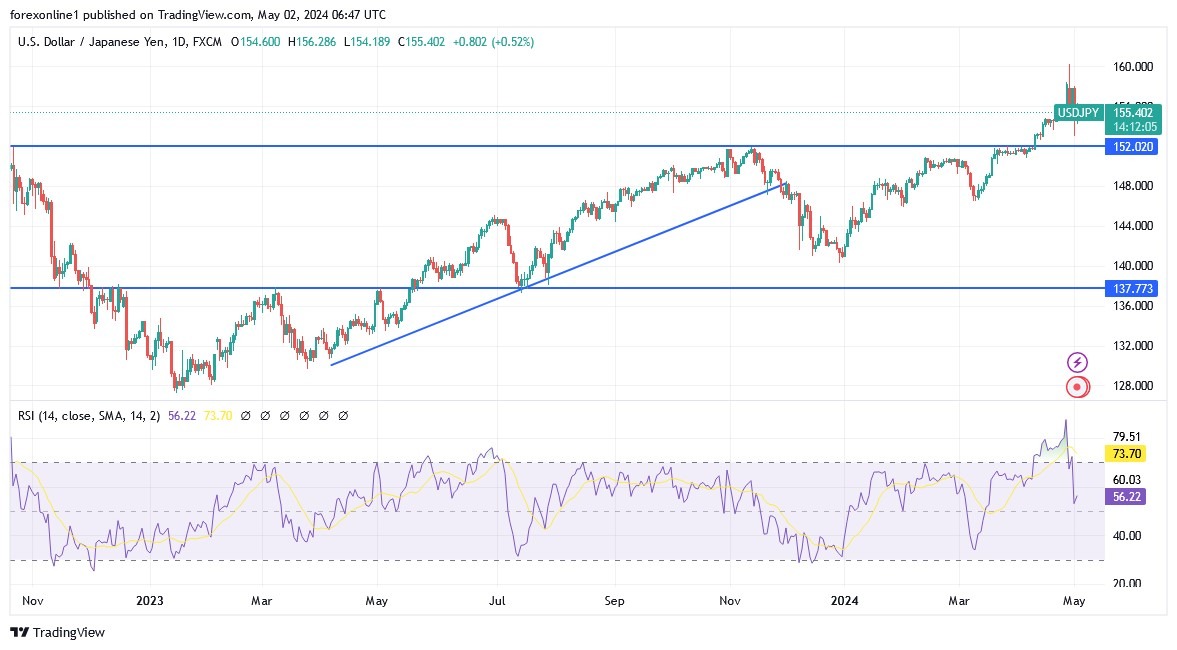- It seems that this week has been the most action-packed for the Japanese yen in the forex market since the start of trading this week.
- It is flying solo and not reacting to market developments except for the focus on Japanese intervention in currency prices to prevent further collapse.
According to forex trading platforms, the USD/JPY pair moved yesterday within the resistance level of 157.98 and the support level of 153.00 before quickly returning to the resistance level of 155.30 at the time of writing this analysis. Moreover, this performance will not be strange from what happened at the beginning of trading this week.
On Monday morning, while many in Tokyo were enjoying a public holiday, Yoshio Iguchi was on high alert at Traders Securities' office in Shibuya. Already, tense forex markets were ripe for official measures aimed at reversing the Japanese yen's decline to its lowest level in more than three decades. The Bank of Japan's decision on Friday was unexpectedly dovish and was unlikely to change the course of the currency. JPY bulls were cautious, and the Golden Week holiday meant trading would be thin.
The 20-year market expert was right to be cautious: At around 10:30 a.m., the yen fell. The drop to $160 immediately filled news reports and social media across Japan. “We cannot let our guard down,” and the other red line levels – 155 and 158 – fell without any pullback. Some began to wonder whether the authorities would act at all.
Around lunchtime, there was a sharp turn on the trading screens. In a matter of minutes, the yen soared by nearly 3% against the dollar, erasing the day's move. Obviously, speculation spread in the markets that officials had intervened to support their troubled currency for the first time in two years. While no intervention has yet been confirmed, Bank of Japan accounts suggest that it may have spent around ¥5.5 trillion ($35.1 billion) to support the currency.
The frenzy of trading — with Monday becoming the busiest day for spot yen trading since 2016, according to CME Group — shows how the Japanese yen has transformed from a currency once known as one of “the most boring currencies in the world” to one of the most heavily speculated on, a victim of the large difference in interest rates in Japan with its peers around the world. Expectations that authorities will have to intervene more frequently unless deep structural issues are resolved suggest that violent fluctuations may become more frequent, with implications for markets outside Japan. On the other hand, the weakness of the currency threatens to strengthen the dollar and destabilize other Asian currencies.
At the heart of the continuing pressures are expectations about where the Bank of Japan's interest rates will eventually end up, even after their historic shift away from sub-zero levels in March. The consensus is that Japan will struggle to catch up with its peers. Moreover, expectations that the United States will ease policy significantly this year have been dashed due to the strong US economy and the Federal Reserve's slogan of raising interest rates for a longer period. Japan's massive debt levels – equivalent to more than 250% of the country's economy – make narrowing this gap difficult, even at interest rates that are less than 500 basis points below the Fed's. Some officials may be loathe to abandon early the policy that helped bring about long-awaited inflation.
Meanwhile, this would keep domestic interest rates away from levels that might tempt investors with the high yields on offer in the US and other currencies, and encourage speculative bets by traders who expect rebounds to be short-lived.
Conversely, some might argue that intervention in the currency, which has fallen sharply since the Fed began raising rates in the US in 2022, was long overdue. While a weak currency generally helps Japanese exporters and boosts domestic tourism, households are under pressure as wage packages fail to keep pace with real prices. In the face of the highest inflation rate in decades, consumers are wary of spending, and discontent with the economy has led to widespread political discontent. This week, the ruling Liberal Democratic Party lost a by-election that Prime Minister Fumio Kishida partly described as a vote of no confidence in himself.
As well, even some of those who initially benefited from the cheaper currency have changed tack, with rising import bills and lacklustre consumer spending weighing on the local economy.
Top Forex Brokers
USD/JPY Technical Analysis and Expectations Today:
By Tuesday, the Japanese yen was trading at around 157 yen to the dollar, nearly half its average value in 2012. It is on track to repeat its title as the world's worst-performing major currency this year after falling by more than 10% against the dollar. The already strong US dollar recovery is turning global markets upside down, thanks to the robust US economy and persistent inflation that prompted the Federal Reserve to postpone US interest rate cuts. The rapid decline of the yen threatens to exacerbate this impact, arousing the ire of other countries concerned about trade imbalances and currency exchange rates.
Overall, the general trend for the USD/JPY exchange rate will remain upward, and this performance is on track for an important event at the end of the week when US job numbers are announced. Ultimately, these figures will have a strong and direct reaction on the future policy of the Federal Reserve.
Ready to trade our Forex daily forecast? We’ve shortlisted the best FX trading platform in the industry for you.

